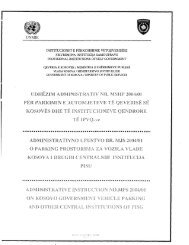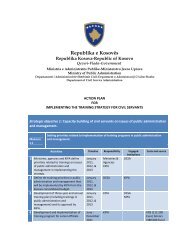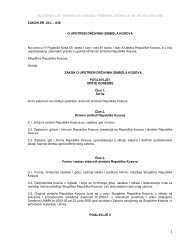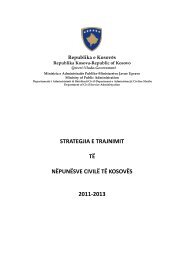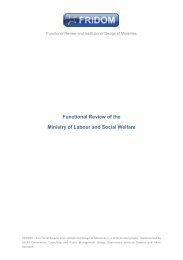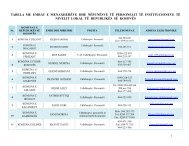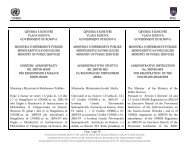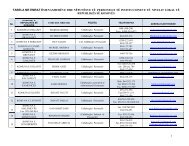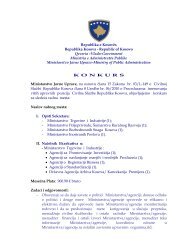Functional Review of the Ministry of Environment and Spatial Planning
Functional Review of the Ministry of Environment and Spatial Planning
Functional Review of the Ministry of Environment and Spatial Planning
Create successful ePaper yourself
Turn your PDF publications into a flip-book with our unique Google optimized e-Paper software.
EXECUTIVE SUMMARY<br />
This vertical review <strong>of</strong> <strong>the</strong> <strong>Ministry</strong> <strong>of</strong> <strong>Environment</strong> <strong>and</strong> <strong>Spatial</strong> <strong>Planning</strong> aims to improve <strong>the</strong> <strong>Ministry</strong>’s<br />
performance in <strong>the</strong> medium-term. To achieve this goal, it sets out a framework <strong>of</strong> changes that can be<br />
implemented in <strong>the</strong> short-term (1-2 years) <strong>and</strong> in <strong>the</strong> medium-term (3-5 years) period. The summary <strong>of</strong> all<br />
recommendations is provided in Section IV <strong>of</strong> this report.<br />
Considerations during <strong>the</strong> whole project execution are based on <strong>the</strong> Kosovo Government’s current<br />
priorities <strong>and</strong> strategies. Actions are recommended to contribute to <strong>the</strong> Government’s goals to become a<br />
member <strong>of</strong> <strong>the</strong> European Union <strong>and</strong> at <strong>the</strong> same time retain <strong>the</strong> national socio-economic growth within <strong>the</strong><br />
principles <strong>of</strong> sustainable development.<br />
MESP has a formal m<strong>and</strong>ate that defines its respective competencies, portfolio <strong>and</strong> functions. These are<br />
established by law <strong>and</strong>, in general, reasonably reflect <strong>the</strong> responsibilities expected. Some difficulties<br />
appear through <strong>the</strong> gap between <strong>the</strong> legally defined functions, i.e. administrative work to be executed -<br />
<strong>and</strong> <strong>the</strong> functions actually discharged, e.g.:<br />
- Cooperation among <strong>the</strong> line ministries - ministries tackling environmental issues are institutionalized<br />
through <strong>the</strong> ad-hoc working groups to solve particular agenda. However <strong>the</strong> Advisory Board for<br />
Protection <strong>of</strong> <strong>Environment</strong> in Government - an <strong>of</strong>ficial decision-facilitating inter-ministerial body – is not<br />
approved yet by <strong>the</strong> Assembly <strong>of</strong> Republic <strong>of</strong> Kosovo (despite <strong>the</strong> provision <strong>of</strong> <strong>the</strong> actual Law on<br />
<strong>Environment</strong> Protection).<br />
- Fund for environmental protection (so called Eko Fund), is mostly financial instrument for improving <strong>the</strong><br />
environmental infrastructure country-wide but is not yet functioning despite it being stated in <strong>the</strong> Law on<br />
<strong>Environment</strong>al Protection.<br />
Major deficiencies have been identified at <strong>the</strong> Inspectorate for <strong>Environment</strong> <strong>and</strong> Water. There are a very low<br />
number <strong>of</strong> genuinely pr<strong>of</strong>essional environmental inspectors. In addition, <strong>the</strong>re is a lack <strong>of</strong> respective legislation,<br />
applicable working methodology, relevant environmental st<strong>and</strong>ards <strong>and</strong> proper coordination <strong>of</strong> <strong>the</strong>ir activities as<br />
well enforcements processes. Modern enforcement concepts <strong>and</strong> st<strong>and</strong>ards, although envisaged by <strong>the</strong><br />
promulgated primary legislation, are not yet in use.<br />
Also in Kosovo, <strong>the</strong>re is an increasing need for unified environmental st<strong>and</strong>ards, harmonised procedures <strong>and</strong><br />
compatible technical solutions which are also not adopted yet.<br />
Although all <strong>the</strong> fundamental institutional elements <strong>of</strong> a regular environmental <strong>and</strong> spatial planning<br />
administration system are present, <strong>the</strong> environmental administration is still undersized <strong>and</strong> under-skilled for<br />
<strong>the</strong> challenges it will have to face. The existing legal provisions reflect concern for <strong>the</strong> basic functions identified<br />
in today’s EU. However, for default-pro<strong>of</strong>, client-friendly <strong>and</strong> internationally recognised yet cost-efficient<br />
delivery, <strong>the</strong> MESP needs to be organised more purposefully, fully covering both <strong>the</strong> core <strong>and</strong> supportive<br />
functions <strong>of</strong> <strong>the</strong> central administration.<br />
It is widely known that a multidisciplinary sector requires an enormous effort <strong>of</strong> strategic planning <strong>and</strong><br />
coordination. Without due coordinating mechanisms, <strong>the</strong> administrative system for environment <strong>and</strong><br />
spatial planning cannot function effectively. Unfortunately, <strong>the</strong> effective horizontal communication <strong>and</strong> topbottom<br />
planning approach are still missing.<br />
Noticeable huge effort was undertaken in <strong>the</strong> policy area. Several strategy documents have been<br />
produced (some <strong>of</strong> <strong>the</strong>m by <strong>the</strong> foreign experts or under <strong>the</strong>ir supervision), e.g. Kosovo <strong>Environment</strong><br />
Action Plan 2006-2010 (KEAP) bringing comprehensive list <strong>of</strong> priority projects spread over all significant<br />
areas <strong>of</strong> environment interest. Then project list within <strong>the</strong> European Partnership Action Plan (EPAP) is<br />
derived from <strong>the</strong> KEAP <strong>and</strong> can easily choose <strong>the</strong> proper projects <strong>and</strong> realize <strong>the</strong>m. Among o<strong>the</strong>r<br />
documents which should be mentioned include: <strong>the</strong> <strong>Environment</strong> <strong>and</strong> <strong>Spatial</strong> <strong>Planning</strong> section <strong>of</strong> <strong>the</strong><br />
Program <strong>of</strong> <strong>the</strong> Government <strong>of</strong> Republic <strong>of</strong> Kosovo 2008 – 2011; Sectoral Strategy for <strong>Spatial</strong> <strong>Planning</strong><br />
2007 – 2013 <strong>and</strong> Business Plan for <strong>the</strong> Kosovo Cadastral Agency 2009 - 2014 are <strong>of</strong> high value. However<br />
o<strong>the</strong>r environmental sectors, i.e. Water <strong>and</strong> Wastewater Management, Solid Waste Management, Air<br />
Quality, Nature Conservation <strong>and</strong> Biodiversity Protection etc. are still without definition <strong>of</strong> clear vision,<br />
mission <strong>and</strong> values.<br />
5



